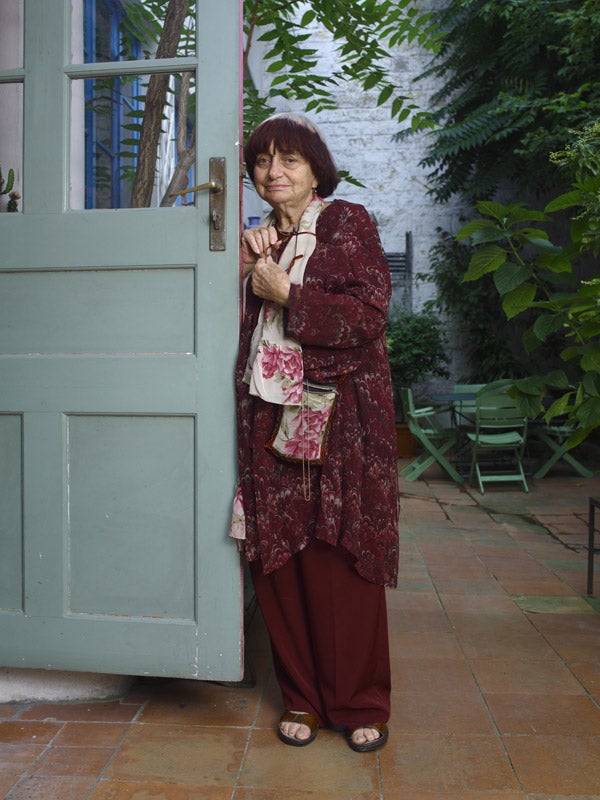Step into my office: Agnès Varda's new career as an installation artist
The little old lady who's lived off the Rue Daguerre since 1951? She started the French New Wave, chronicled the Black Panthers and was a pioneering feminist...And now, aged 81 she has a new career...

Your support helps us to tell the story
In my reporting on women's reproductive rights, I've witnessed the critical role that independent journalism plays in protecting freedoms and informing the public.
Your support allows us to keep these vital issues in the spotlight. Without your help, we wouldn't be able to fight for truth and justice.
Every contribution ensures that we can continue to report on the stories that impact lives

Kelly Rissman
US News Reporter
Would you be shocked if your octogenarian grandmother started attending art shows dressed as a potato? What if she suddenly embarked on a new career as an installation artist? French film-maker Agnès Varda has done just that. At 81, this grandmother of four, who can also justifiably be called the godmother of the French New Wave, has recently followed a new path in life and is thriving in the world of gallery installation: her latest piece, inspired by beach huts, features in the current Lyon Biennale.
Beaches are a running theme with Varda: her new autobiographical documentary The Beaches of Agnès reviews her life as a series of coastal landscapes, from the Mediterranean French port of Sète, to her one-time home of Venice, California. Varda is even seen transforming her Paris street by installing tons of sand, inverting ' a revolutionary slogan of 1968; in her case it's "Under the beach, the pavement."
Varda made her first film in 1954, La Pointe-Courte, a love story set against a semi-documentary portrait of the Sète fishing community. The film is often seen as a precursor to the Nouvelle Vague, whose members Varda and her husband Jacques Demy – the director of such delirious masterpieces as The Umbrellas of Cherbourg – came to know later. Demy's first feature Lola and Varda's own Cléo de 5 à 7 were financed thanks to the box-office success of Jean-Luc Godard's and François Truffaut's debuts. In Cléo (1962), about a pop singer facing her own mortality, Varda offered a rare alternative to the largely male perspectives of the Nouvelle Vague.
On a balmy autumn day, Varda serves tea and biscuits in what amounts to her private city beach, a small courtyard off Rue Daguerre in Paris's Montparnasse district. An enclosed oasis, decked out with plants and assorted shades of crimson and purple, the courtyard lets in only occasional sounds from outside. Varda smiles at a yell from the street: "Neighbours' noises – I love that." A maze of rooms on the ground floor of Varda's home leads to the office of her production company; her daughter, the costume designer Rosalie Varda, lives next door. Showing me around, Varda stops to point at a tiny HD camera at the sofa, on which her cat is draped upside-down with three kittens. "They never lie like this – I must film it while I have the chance."
In The Beaches of Agnès, Varda introduces herself knowingly as "playing the part of a little old lady". It's a stylised role she has adopted in daily life: the eccentric bohemian matriarch, her hair-do a silver mushroom bob rimmed with aubergine. Her self- presentation, in life and in The Beaches of Agnès, testifies to a flair for spectacle that derives, Varda says, from her first cultural passion, the circus. "I didn't see movies until I was 25 years old, but I went to the circus every month when I was young." That is why, when invited to the Venice Biennale to present her video about potatoes, she dressed as a potato herself. "I thought, 'I'm only one young artist, among 500 artists. Who will come to my show?' Then I remembered that circuses used to parade through villages before the show – a clown, a goat, a monkey, 'Tonight at 9 in the main square!' I thought I should do something to get attention."
As The Beaches... reveals, Varda is very much her own invention. The doyenne of French directors, she is actually Belgian-born, of Greek descent, and named herself Agnès in preference to her given "Arlette". The film follows the young Varda from Belgium to Sète, where her family lived on a boat during the Second World War; then to Paris, where she studied at the Louvre. Her father, an industrial designer, never cared much for art and culture. Her own desire to be an artist, she says, came from "rejecting the bourgeoisie. We all become bourgeois when we have a house. I have a house now, a bathroom – two bathrooms! We become bourgeois in terms of the way we live – but in terms of spirit, that's another thing. When I was very young, I hated it, I needed to get out and have an artistic life."
Varda found that life working as a photographer, documenting the early days of the Avignon Festival. It was as a photographer that she visited China in 1957, then Cuba in 1962, where she took an exhaustive set of images, including a portrait of Fidel Castro as an angel with stone wings. She turned to film more or less on a hunch, she says. "I thought photography wasn't enough. I had an idea that I could make a film that was words, music, images and movement – I thought, that will be art. If I'd seen the masterpieces I saw later, maybe I wouldn't have dared to start."
In fact, Varda never shared the obsessive cinephilia of Godard and co: "They'd seen everything. I'd never heard of American cinema." Her and Demy's real kindred spirits were their Left Bank friends and occasional collaborators Chris Marker and Alain Resnais, themselves titans of French cinema. "Our opinions were more to the left than all the Nouvelle Vague bunch, which was slightly to the right. And they were on the Champs-Élysées – something of a metaphor there."
In her quest for bohemian independence, Varda moved into Rue Daguerre in 1951, when the courtyard was wedged between a grocery and a picture-framing workshop. "There was no heating, no bathroom, nothing. I'd throw buckets of water over myself in the toilet to shower."
Demy soon joined her, and the pair lived and worked together in the house over four decades. It became home to their children, Rosalie – Varda's daughter from a previous relationship – and Mathieu Demy, born in 1972, now a screen actor. The Beaches... shows the house as a remarkable hub of activity: one archive sequence shows Varda rehearsing in one room while, across the courtyard, Demy works at the piano with the composer Michel Legrand. Today, Varda has expanded her space, editing in a shop across the road, where you can also walk in and buy her DVDs: "It's like buying tomatoes directly from the farmer."
Varda and her husband had two extended spells in California, first in the late 1960s when Demy made Model Shop for Columbia, possibly the most melancholic studio film ever set in Los Angeles. Varda shot screen tests of a potential star, but the studio thought the young unknown had no future; his name was Harrison Ford. She made her own document of the hippie era: Lions Love, in which Warhol
superstar Viva enjoys a ménage à trois with the creators of Hair!. And she filmed the then-ascendant Black Panther movement.
Varda can counter with such political interests when people ask her, often reproachfully, whether she regrets missing May '68 in Paris. In California, she says, "We had peace and love, we had flower children, we had love-ins and sit-ins and huge free concerts. What we found was a real desire for brotherhood that was magnificent, that wasn't just about making demands. I wasn't [in Paris], that's all there is to it – but I saw things they didn't see."
She and Demy also became friends with the Doors singer Jim Morrison. "I think he liked us because we never asked him for anything. He used to come here and we'd eat in the courtyard. And I was so dumb, I never even took his photo as I didn't want to disturb him. I knew lots of people I should have photographed a lot better. I was too shy."
Varda and Demy returned to Los Angeles in the early 1980s, a sadder period marked by temporary separation. But the couple reunited and stayed together until 1990, when Demy died after an Aids-related illness. Immediately before his death, Varda made a poignant memorial to him, Jacquot de Nantes, in which she painstakingly staged her recreation of Demy's childhood. "I really hoped to grow old with him, that was the plan. When you see a couple growing old together, it's really something, isn't it?"
As a film-maker, Varda has always caught the mood of her times. She was a committed participant in the 1970s surge of French feminism, for which her film One Sings, the Other Doesn't stood as a rallying call. A turning point in her practice came in 2000 when she discovered the new possibilities of hand-held digital cameras. The result, The Gleaners and I, was inspired by the people she saw collecting discarded food when her local market was packing up: the film, an essay on scavenging for food and for inspiration, has been adopted as a manifesto for socially conscious, no-budget, first-person cinema. Varda depicts herself in the film as a gleaner of images, although, she points out, "Gleaning really relates to people who have nothing and have to grab what we throw away. When I'm picking, I'm more like someone in a flea market, looking around and eventually buying cheap."
Since The Gleaners..., Varda's profile has been higher than ever, not least because of her spectacular 2006 installation at Paris's Fondation Cartier, a multi-piece contemplation – variously sombre and larky – of the sea, mortality and her island holiday home in western France.
Officially a grande dame, Varda has had her share of medals, culminating in the fabled Légion d'honneur earlier this year. I offer my congratulations, but she corrects me: "No, please – congratulate me on my films." What really pleases her, she says, is connecting with an audience. "My box-office is very low compared with big productions, but I'm lucky – my films are seen everywhere. In the margins," Varda says proudly, "I'm a princess."
'The Beaches of Agnès' (18) is on limited release. The Agnès Varda DVD box sets are out on 5 October (volume one, including 'Cléo de 5 à 7' and 'The Gleaners and I') and February 2010 (volume two, including 'The Beaches of Agnès')
Subscribe to Independent Premium to bookmark this article
Want to bookmark your favourite articles and stories to read or reference later? Start your Independent Premium subscription today.
Join our commenting forum
Join thought-provoking conversations, follow other Independent readers and see their replies
Comments